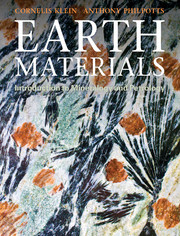Book contents
- Frontmatter
- Contents
- Preface
- Acknowledgments
- Chapter 1 Introduction
- Chapter 2 Materials of the solid Earth
- Chapter 3 How are minerals identified?
- Chapter 4 Fundamentals of crystal structures
- Chapter 5 Introduction to crystallography
- Chapter 6 Minerals and rocks observed under the polarizing optical microscope
- Chapter 7 Igneous rock-forming minerals
- Chapter 8 How do igneous rocks form?
- Chapter 9 Igneous rocks
- Chapter 10 Sedimentary rock-forming minerals and materials
- Chapter 11 Formation, transport, and lithification of sediment
- Chapter 12 Sedimentary rock classification, occurrence, and plate tectonic significance
- Chapter 13 Metamorphic rock-forming minerals
- Chapter 14 Metamorphic rocks
- Chapter 15 Some economic minerals, mainly from veins and pegmatites
- Chapter 16 Some selected Earth materials resources
- Chapter 17 Earth materials and human health
- Glossary
- Minerals and varieties
- Common igneous, sedimentary, and metamorphic rocks
- Index
- References
Chapter 7 - Igneous rock-forming minerals
- Frontmatter
- Contents
- Preface
- Acknowledgments
- Chapter 1 Introduction
- Chapter 2 Materials of the solid Earth
- Chapter 3 How are minerals identified?
- Chapter 4 Fundamentals of crystal structures
- Chapter 5 Introduction to crystallography
- Chapter 6 Minerals and rocks observed under the polarizing optical microscope
- Chapter 7 Igneous rock-forming minerals
- Chapter 8 How do igneous rocks form?
- Chapter 9 Igneous rocks
- Chapter 10 Sedimentary rock-forming minerals and materials
- Chapter 11 Formation, transport, and lithification of sediment
- Chapter 12 Sedimentary rock classification, occurrence, and plate tectonic significance
- Chapter 13 Metamorphic rock-forming minerals
- Chapter 14 Metamorphic rocks
- Chapter 15 Some economic minerals, mainly from veins and pegmatites
- Chapter 16 Some selected Earth materials resources
- Chapter 17 Earth materials and human health
- Glossary
- Minerals and varieties
- Common igneous, sedimentary, and metamorphic rocks
- Index
- References
Summary
After three short sections on common elemental abundances in the Earth’s crust, the recalculation of mineral formulas from their chemical analyses, and the application of triangular (ternary) diagrams to the depiction of the chemistry of minerals, we start the systematic descriptions of igneous rock-forming minerals. We chose 29 of these as the most representative, of which 19 are silicates, 6 are oxides, 3 are sulfides, and 1 is a phosphate.
Section 7.5 is the first mineral entry of the systematic description of igneous rock-forming minerals that follow. You must read these descriptions to become familiar with the most common minerals; their composition, structure, and physical properties; and their uses in the present-day commercial world. Reading the mineral description in this text while handling one or several specimens of the same mineral in the laboratory that accompanies your course is the best way to familiarize yourself with the mineral’s properties. Minerals that are common constituents of sedimentary and metamorphic rocks and of vein deposits are presented after the origin of igneous rocks and their classification, in Chapters 8 and 9.
- Type
- Chapter
- Information
- Earth MaterialsIntroduction to Mineralogy and Petrology, pp. 156 - 191Publisher: Cambridge University PressPrint publication year: 2012



